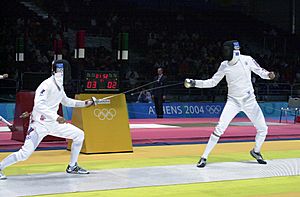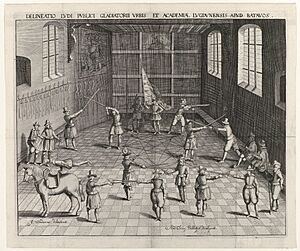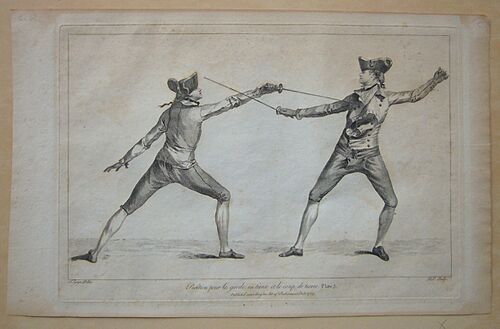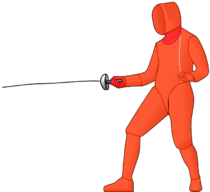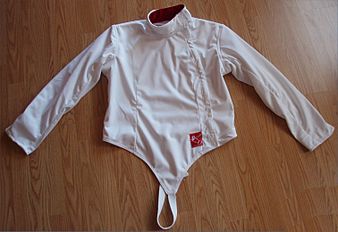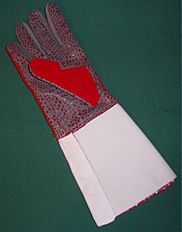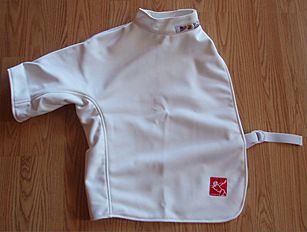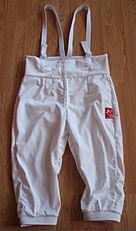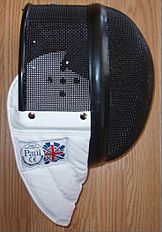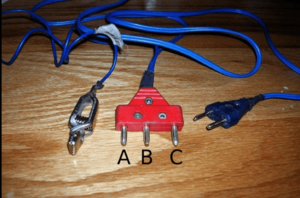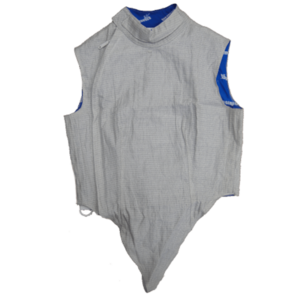Fencing facts for kids
Fencing is a fun and exciting sport where two people use special swords to try and score hits on each other. It's like a fast-paced game of tag, but with swords! A referee makes sure everyone follows the rules.
Contents
History of Fencing
Fencing has a long history. It started from how people used swords for self-defence and in duels (formal fights). One of the oldest books about fencing in the Western world is from around 1300 in Germany. It teaches how to use a sword with a small shield.
Modern fencing, as we know it today, began to take shape in the 1700s. Italian and French fencing schools helped create the rules and moves.
Fencing Becomes a Sport
In the mid-1700s, fencing started to become more of a sport and less about military training. A man named Domenico Angelo was very important in this change. In 1763, he opened a fencing school in London. He taught rich people the fancy art of swordsmanship. His family ran the school for almost 100 years!
Angelo created many of the basic rules for how fencers should stand and move their feet. These rules are still used in fencing today.
The first official fencing competition happened in London in 1880. It was part of a big military event. Soldiers and officers competed, trying to get five hits. The tips of their foils (swords) were black to help the judges see the hits. In 1896, the Amateur Gymnastic & Fencing Association made official rules for the sport.
Fencing at the Olympics
Fencing has been part of the Summer Olympics since the very first modern games in 1896.
- The sabre event has been in every Olympics.
- The foil event has been in every Olympics except 1908.
- The épée event has been in every Olympics except 1896.
In 1933, a new electrical scoring machine was invented for épée. This machine made a sound and showed a red or green light when a hit landed. This made judging much fairer. Foil fencing got this system in 1956, and sabre in 1988. The scoring box helped judges see faster hits and lighter touches.
Fencing Weapons
There are three main weapons used in fencing. Each weapon has its own rules and ways of playing.
Foil Fencing
The foil is a light sword, weighing up to 500 grams (about 1.1 pounds). In foil fencing, you can only score hits on your opponent's torso (the body, but not the arms or legs). The foil has a small round hand guard to protect your hand.
You can only score a point with the tip of the foil. If you hit with the side of the blade, it doesn't count. If you hit outside the target area, the scoring machine shows a different color light, and the action stops. Only one fencer can score a point at a time. If both fencers hit at the same time, the referee uses a rule called "right of way" to decide who gets the point.
Épée Fencing
The épée is also a thrusting weapon, like the foil, but it's heavier. It can weigh up to 775 grams (about 1.7 pounds). In épée, you can hit your opponent anywhere on their body to score a point. The épée has a large, bell-shaped hand guard that covers the whole hand, because the hand is a valid target.
Just like foil, you can only score with the tip of the blade. If you hit with the side, it doesn't count. Since the whole body is a target, there's no such thing as an "off-target" hit, unless you accidentally hit the floor. Unlike foil and sabre, épée doesn't use the "right of way" rule. If both fencers hit each other at the same time, both get a point. This is called a "double touch."
Sabre Fencing
The sabre is a light weapon, also weighing up to 500 grams. It's unique because you can score points by cutting with the side of the blade, not just thrusting with the tip. In sabre, the target area is the entire body above the waist, including the head and hands.
The sabre has a guard that protects the hand and forearm. If you hit outside the target area, it doesn't count, but the action doesn't stop. Fencing continues until a valid hit is made. Like foil, if both fencers hit at the same time, the referee uses the "right of way" rule to decide who gets the point.
Fencing Equipment
Fencers wear special protective gear to stay safe during matches.
Protective Clothing
Most fencing clothing is made from strong cotton or nylon. Some top-level uniforms also use Kevlar or Dyneema to make them extra strong and resistant to punctures. This is very important for safety. FIE rules (the international fencing rules) say that competition clothing must be able to resist a force of 800 Newtons (about 180 pounds of force).
A complete fencing outfit includes:
- Jacket: This fits snugly and has a strap that goes between the legs. It has a small collar to protect the neck.
- Plastron: This is an extra protector worn under the jacket on the sword arm side. It gives double protection.
- Glove: A thick glove protects the sword hand and wrist. It also helps the fencer hold the weapon better.
- Breeches: These are short trousers that end just below the knee. They must overlap with the jacket by at least 10 centimeters (about 4 inches).
- Socks: Fencing socks are long enough to cover the knee.
- Shoes: Fencing shoes have flat soles and are reinforced in certain areas to prevent wear from lunging.
- Mask: The fencing mask has a strong metal mesh to protect the face and a bib that protects the neck. It's designed to withstand a lot of force.
- Chest protector: This plastic protector is worn by female fencers and sometimes by males. Fencing coaches often wear them too, as they get hit a lot during training.
- Lamé: This is a special jacket or vest made of electrically conductive material. It's worn over the regular jacket in foil and sabre fencing. It covers the target area, so when the opponent's weapon touches it, the scoring machine lights up. (Épée fencers don't need a lamé because the whole body is a target).
- Sleeve: A coach might wear a protective sleeve on their arm or leg for extra protection during practice.
- Elements of protective clothing
Fencing uniforms are traditionally white. This is because, in the past, fencers would put dye or chalk on their sword tips to show where hits landed. White uniforms made it easy to see the marks. Today, with electric scoring, fencers can wear colored uniforms, but there are rules about logos.
Electric Fencing Gear
To use the electric scoring system, fencers need special electric equipment.
- Body cord: This is a wire that connects the fencer to a reel of wire. The reel is part of the system that detects when a weapon touches the opponent.
- For épée, the body cord has two sets of three prongs. One set plugs into the weapon, and the other connects to the reel.
- For foil and sabre, the body cord has two prongs for the weapon and a third wire that connects to the fencer's lamé. This is because foil and sabre need to tell the difference between hits on target and hits off target.
- How it works:
- In foil, the lamé is connected to one wire (A line), and the tip of the weapon to another (B line). When the tip hits the lamé, it completes a circuit and a valid touch is scored. If the tip hits off-target, a different light shows.
- In épée, the tip of the weapon connects two wires (A and B lines) when it's pushed in. If it hits the opponent, a valid touch is scored.
- In sabre, the lamé is connected to one wire (A line), and the whole blade is connected to another (B/C line). Any contact between the blade and the opponent's lamé scores a valid touch.
A full set of electric foil equipment includes:
- An electric body cord.
- An electric blade.
- A conductive lamé (electric vest).
- A conductive bib (on the mask).
- An electric mask cord, connecting the bib to the lamé.
Electric sabre equipment is very similar to foil, but with a larger lamé, an electric sabre, a fully conductive mask, and a conductive glove. Épée fencers don't use a lamé or conductive bib, but they have all the other parts of a foil fencer's equipment.
Fencing Techniques
Fencing moves can be split into two main types: offensive (attacking) and defensive (protecting). Some moves can be both! Fencers combine footwork and hand actions in many ways.
Offensive Moves
- Attack: This is a basic move where you extend your arm and threaten your opponent's target area. In sabre, attacks can also be made by cutting.
- Riposte: This is an attack made by the defender right after they have successfully blocked their opponent's attack.
- Feint: A fake attack used to make your opponent react.
- Lunge: A powerful move where you push forward with your back leg and extend your front leg to reach your opponent.
- Beat attack: You hit your opponent's blade to gain an advantage, then continue your attack.
- Disengage: You move your blade around your opponent's blade to hit a different part of the target or trick them.
- Flick: A technique mostly used in foil and épée. You bend the flexible blade to whip the tip onto an opponent's hidden target area.
- Flèche: An attacking move where you lean forward and then run past your opponent after scoring a touch.
- Flunge: A special flying lunge used by sabre fencers.
Defensive Moves
- Parry: A basic defensive move where you block your opponent's weapon to push it away from your target area. After a parry, you often follow with a riposte.
- Circle parry: A parry where you move your weapon in a circle to catch and deflect your opponent's blade.
- Counter attack: An attack made while moving away from your opponent's attack. This is often used in épée to hit the opponent's hand or arm.
- Point-in-line: A position where your arm is straight, and your weapon's point is aimed at your opponent's target. In foil and sabre, this can give you priority.
Other Fencing Types
Besides the main Olympic fencing, there are other cool types of fencing:
- Wheelchair fencing: This is for athletes with disabilities.
- Chair fencing: Similar to wheelchair fencing, but for able-bodied fencers who sit on chairs. All the usual rules apply.
- One-hit épée: This is one of the five events in modern pentathlon, a sport with five different challenges.
- Lightsaber fencing: Yes, really! This fun variant uses toy lightsabers and has even been shown on TV!
See also
 In Spanish: Esgrima para niños
In Spanish: Esgrima para niños


